Blog Archives
What Happened Today at the Monastery?
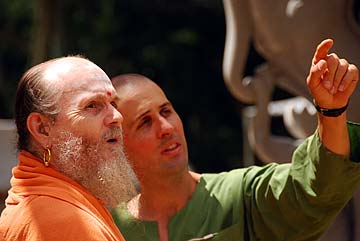
Today is the fourth day of the waxing moon in the month of Simha, Lord Ganesha Birthday here in Hawaii.
But so much more happened today…. Here Bodhinatha is observing the raising up of another jalakam at Iraivan. Sadhaka Tejadevanatha shares with him some of the technical details.
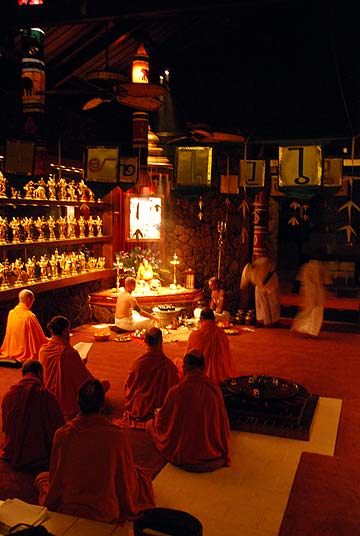
It was also Chitra Nakshatra this morning and we observed the monthly pada puja for Gurudeva.
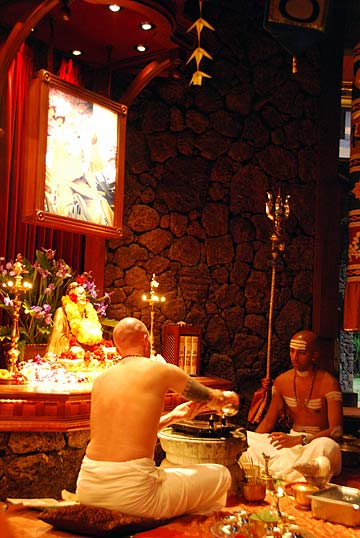
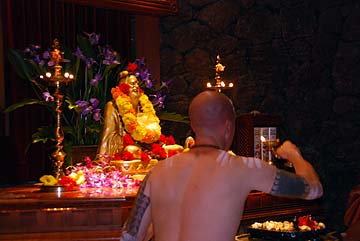

Our whole silpi crew poses with Palaniswami after the puja, appropriately with Iraivan Temple in the background, visible just behind swami’s left shoulder.
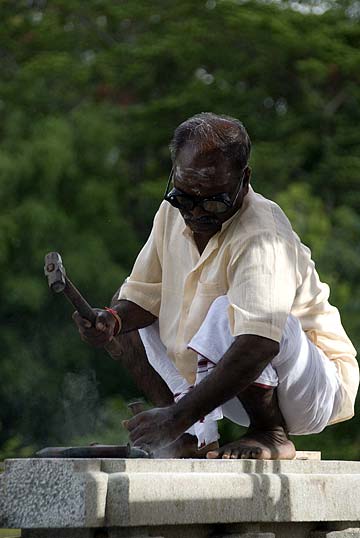
Then off to work. The jalakam has small “knobs” or protrusions that will need to go into small holes which Karuppiah is making on the top of this narrow railing where the jalakam will sit.
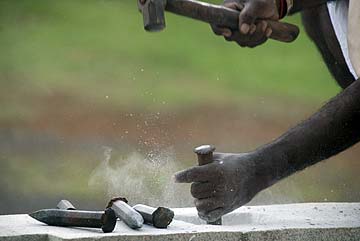
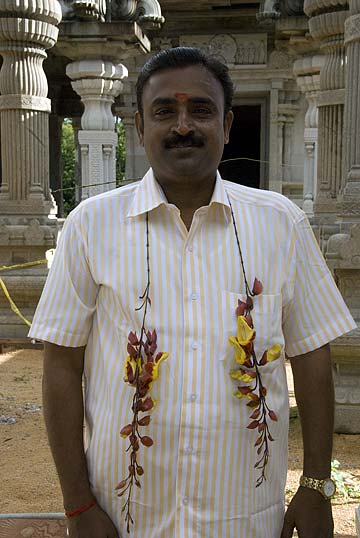
And yet another auspicious event. Today is Selvanathan Sthapati’s birthday! A fine soul and a great asset to the Iraivan project. He sends all his love back to his family in India. He was amazed that he was here last year on this important personal day.
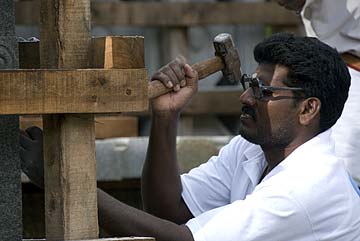

First, we extract the jalakam from its crate.

Yoginathaswami guides everything along very carefully making sure the project goes without a hitch.

We have to first put up the top of the pillar next to the jalakam.
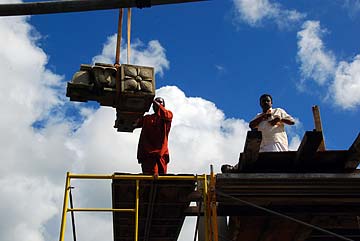
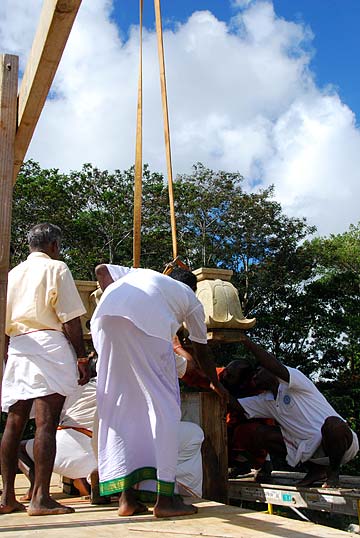
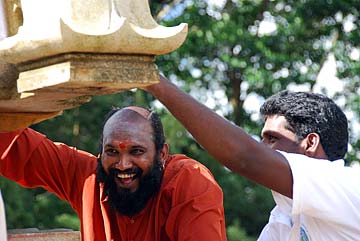
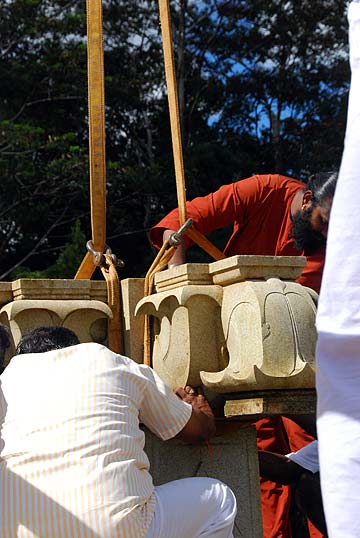
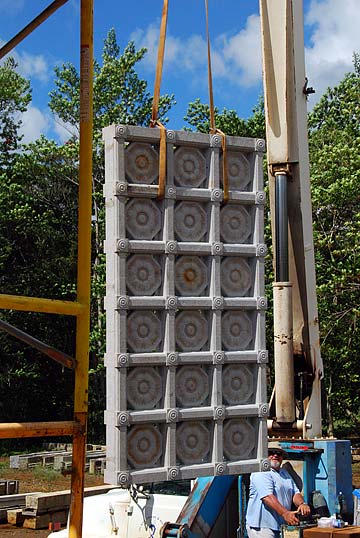
The jalakam is next. A huge stone weiging 6,000 pounds, a magestic stone window through which you can see the surrounding landscaping.
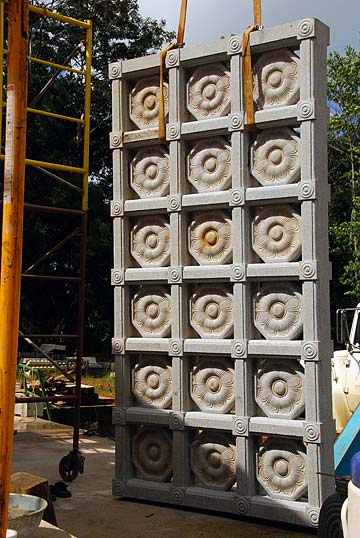

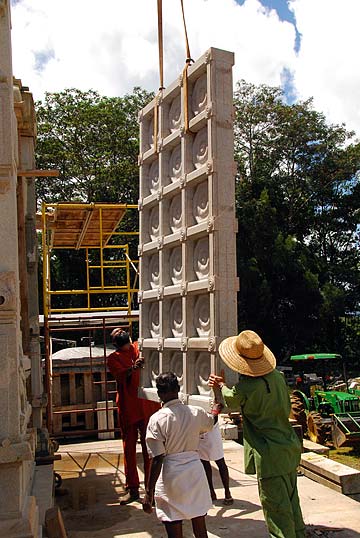
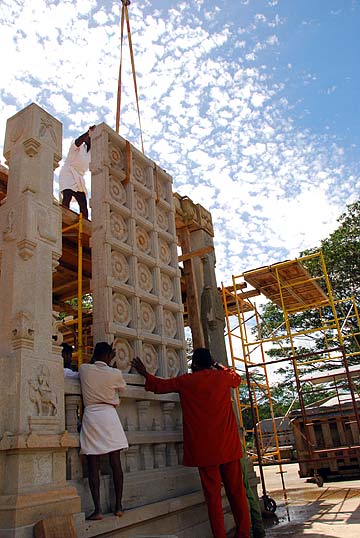
The team is naturally anxious as this giant stone window is set down on one end on top of the narrow railing with no other support than gravity!
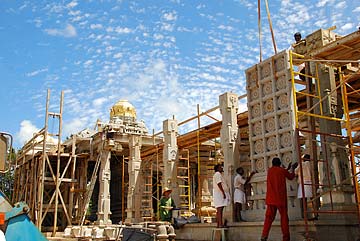
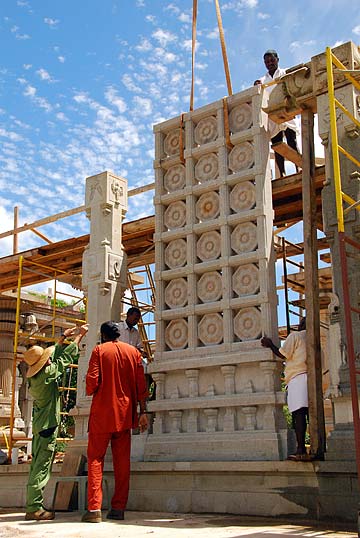
But everything is precisely plump, precisely level and the huge panel of granite sits there as if it had been there all its life.
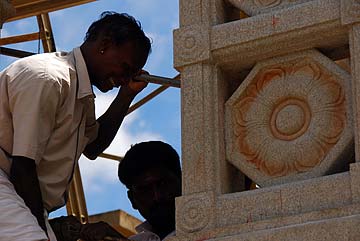
Minute final adjustments.
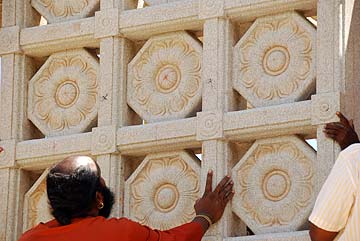

The fitting is taking time… we have to take the panel up again and make some more adjustments.
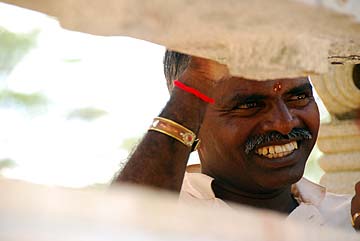
After over 2 hours of careful work the jalakam takes its final resting place…
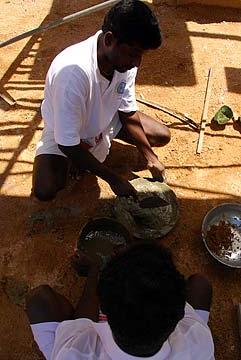
Mortar is prepared. it is just a thin layer to fill the spaces underneath the stone and does not really bind the temple together as such.
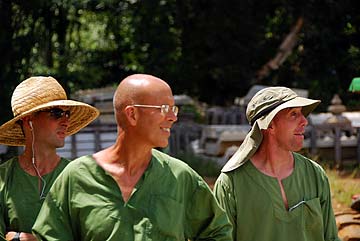
Our Siddhidata Kulam team watches with delight. It is always great day when another major element of Iraivan is installed.
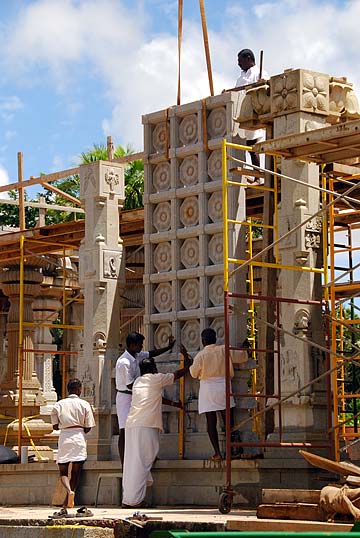
Looking good!
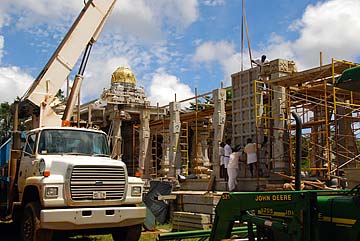
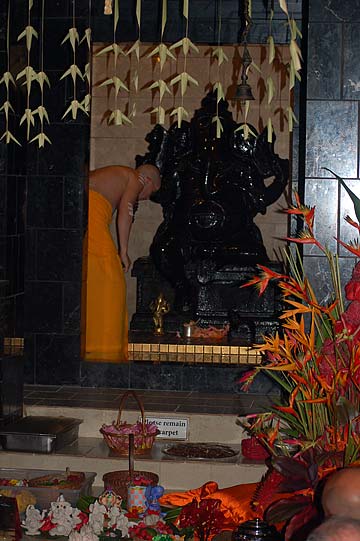
Then at 3 pm we had our annual Ganesha Abhishekam for Ganesha Chaturthi. Normally our devotees never see this because Ganesha’s daily abhishekam is at 3 am in the morning when only monks are on the property.
We bring you excerpts from Gurudeva’s writing on the beloved Elephant-Faced Lord…
“Lord Ganesha is the first God a Hindu comes to know. As the Lord of Categories, His first objective is to bring order into the devotee’s life, to settle him into the correct and proper flow of his dharma–the pattern of duties, responsibilities and expectations suited to the maturity of his soul. As the Lord of Obstacles, He deftly wields His noose and mace, dislodging impediments and holding avenues open until the individual is set in a good pattern, one that will fulfill his spiritual needs rather than frustrate them.”

It is always a special and amazing site to watch the abhishekam of the giant and beautifully carved Maha Ganapati in Kadavul temple.
“Always remember that Ganesha does not move swiftly. He is the elephant God, and His gait is slow and graceful. As the God of the instinctive-intellectual mind, His darshans are carried on the slower currents of mind, and so His response to our prayers is usually not overnight or sudden and electric, but more deliberate and gradual. Yet, our patience is rewarded, for His work is thorough and powerful, of matchless force persisting until our lives and minds adjust and our prayer has become reality.”

Milk….
“Lord Ganesha is also known as the Gatekeeper. Access to all the other Gods comes through Him. It is not that He would want to keep anyone from another God, but He prepares you to meet them and makes the meeting an auspicious one. This preparation can mean lifetimes. There is no hurry. It is not a race. Ganesha will faithfully bar access to those who do not merit a divine audience and an ensuing relationship with the other Deities whose darshans are faster. Should a devotee gain unearned access and invoke the powers of other Deities before all preparations were concluded, karma would accelerate beyond the individual’s control. Worship of Lord Ganesha, however, may begin at any time.”
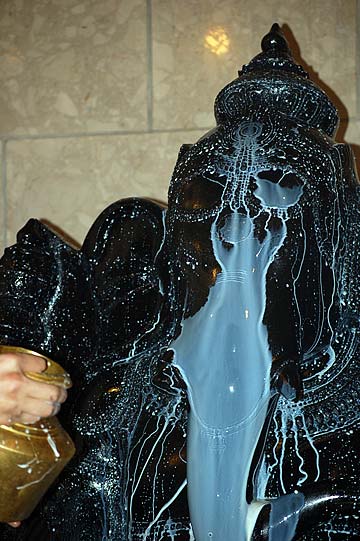
“Ganesha is the ubiquitous God. There are more shrines, altars and temples for Lord Ganesha than for any other God. Ganesha bhakti is the most spontaneous worship and the simplest to perform. It requires little ritual. Just the ringing of a small bell at the outset of a project before His picture or the burning of camphor or the offering of a flower is enough to invoke His presence and protection. Throughout India and Sri Lanka, there are small, unadorned shrines to Ganapati under shaded trees, along country roads, at bus terminals, along footpaths and in the city streets. His blessings are indeed everywhere. Helping Ganesha, whose powers of mind outreach the most advanced computers we can conceive, are His ganas, or devonic helpers. These ministering spirits collect the prayers of those in need, ferret out and procure the necessary information and bring it before Lord Ganesha’s wisdom.”
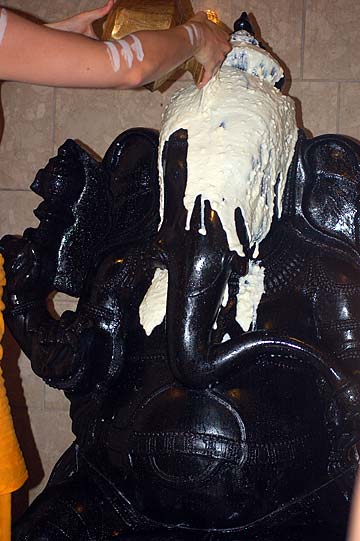
Yogurt….
“If you want to get acquainted with the Gods, first get to know Lord Ganesha. Take a picture and look at it. Put a picture of Lord Ganesha in your car or in your kitchen. Get acquainted through sight. Then come to know Him through sound by chanting His names and hymns. This is how you get acquainted with your personal Deity. You will get to know Him just as you know your best friend, but in a more intimate way, for Ganesha is within you and there ahead of you to guide your soul’s evolution. As you get acquainted with Him, Ganesha then knows that you’re coming up on the spinal climb of the kundalini. He will work with you and work out your karma. Your whole life will begin to smooth out.”
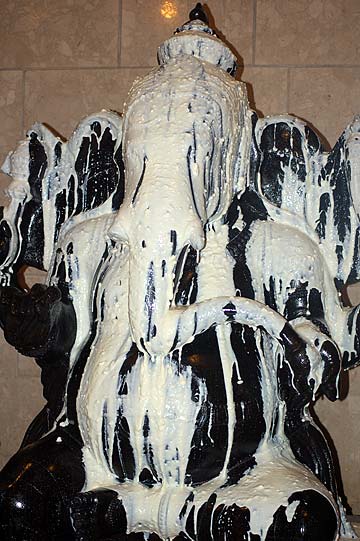
“On occasion we observe devotees pilgrimaging to a temple, prostrating so devotedly. But after leaving the temple, they slap one of their children. We know that upon entering the house they argue with their spouse and complain about their in-laws. Where is the true bhakti here? This is what bhakti is not. Unfortunately, the children who observe this hypocrisy remember it for a long, long time. A child might think, “You love Lord Ganesha, Mom, but you can’t love me.” When you love a baby, you will not hit it when it cries, even if the crying disturbs you.”

Young coconut water…
“We can see that coming up through the lower chakras is quite an ordeal. But once the individual goes through the fear chakra, he comes to Lord Ganesha’s feet and enters the realms of memory and reason, clarity and understanding. It is at this point in the unfoldment through the chakras, which is a journey of consciousness, that he would begin thinking of others and seek to benefit them more than himself. From here on, the path of spiritual unfoldment is not as ominous as it was before. There are no threatening areas, except that it is possible to fall back into lower consciousness.”

Sandalwood powder…
“The Gods are the controllers of these force centers within man. They live in the innermost areas of form. To enter the muladhara chakra, the aspirant must go through Lord Ganesha. And when the aspirant progresses to the manipura chakra, Ganesha will introduce him to Lord Muruga. Once this is accomplished, the devotee will worship Lord Muruga as the Be-All and End-of-All, just as Ganesha was worshiped when consciousness was in His chakras. Lord Muruga is the controller of the manipura chakra, the chakra of willpower, and the two chakras above it, direct cognition and universal love. Now we can begin to see that the aspirant has to proceed in consciousness through the three chakras that Lord Muruga controls and meet all the tests before this God will introduce him to Lord Siva. Lord Siva’s realm is chakras number six, seven and beyond. The aspirant still must go completely through the chakras of Lord Siva’s realm to become Sivaness–to experience His all-pervasiveness, and on into the essence of all essences, Parasiva.”
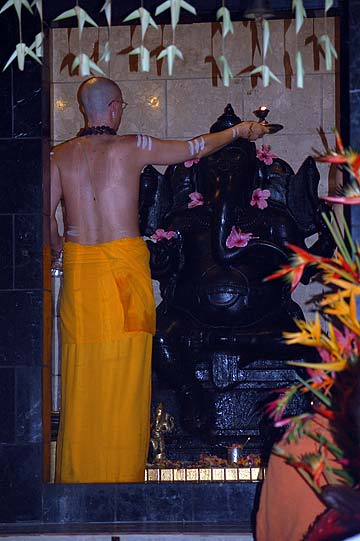
“When the devotee has proven himself, the Gods begin to take notice. We meet a God as we go up through the chakras above the muladhara. We meet an asura as we go down through the chakras below the muladhara. A God appears as each higher chakra breaks open. As the muladhara opens and awareness comes through it, we encounter Ganesha. When we experience fear and anger, we meet and are influenced by the asuras of fear and anger. In the chakra that governs confused and selfish thinking, we meet and are influenced by the asura who rules this realm. Descending to the still lower chakras of petty theft, fraud and stealing, grand larceny, murder and violence, we would meet professionals in these areas.”
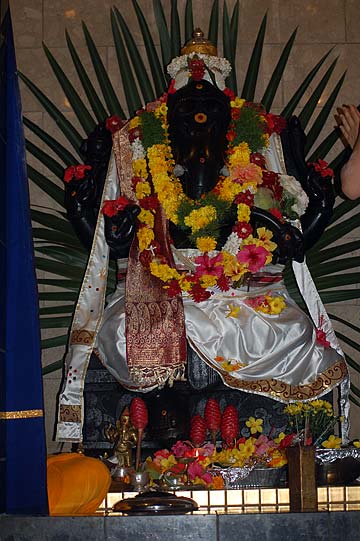
After the puja….
“For the non-Hindu who has not made a commitment, the universal mantra Aum is the most significant and precious of all mantras. This can be chanted by those of all religions, without restriction. The sounds of a city make “Aum.” A child at birth says “Aum.” A mother giving birth says “Aum.” The last breath of a dying person is “Aum.” Even the cows say “Aum.” Aum is the mantra of Lord Ganesha. All are striving for His holy feet. Those who are struggling with the lower nature, those who have not made a commitment to the Sanatana Dharma, a commitment which for the newcomers to the fold could be verified by their Hindu name on their passport, should all chant Aum.”

Small plaster Ganesha’s are waiting to go to the Visarjana which followed.
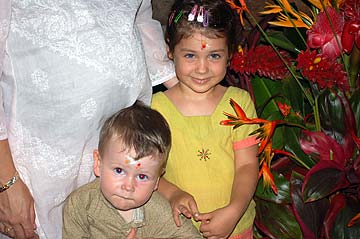
It is always a bright day for little ones.
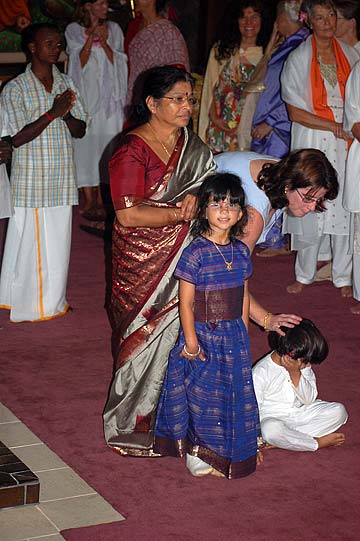
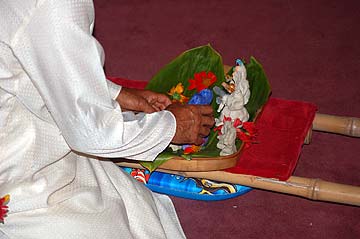
We will bring you more picture of the Visarjana tomorrow.
For Wikipedia fans:
The first page of Wikipedia today points to this article as one of today’s important world events:
From Our Gurus' Teachings
Archives are now available through 2001. Light colored days have no posts. 1998-2001 coming later.
